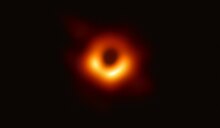User:Ashish Menon 21

Astronomers have spend much time analysing how stars form and how they develop. One problem was to explain what happened to a massive star at the end of its life. In 1967, the term "black hole" was used to describe one type of object that is left when a massive star dies. Four years later, cygnus X-1 was found, the first candidate for a black hole.
Detecting a black hole
Black holes appear black because nothing, not even light, can escape from their powerful gravity. Astronomers cannot detect them directly but can "see" them because of the effect their gravity has on everything around them, such as gas from nearby star. The boundary of the black hole is called Event Horizon. Material pulled in towards the hole is swirled around by the gravity, forming a disc, before crossing the Horizon.
Stellar collapse
Massive stars can end their life in an explosion called a supernova, that leaves behind a central core. If the core's mass is more than that of three suns, it becomes a black hole. Gravity forces the core to collapse. As the core shrinks, its gravity increases. At a certain point it reaches a critical size, that of an Event Horizon.
Supermassive holes
Some galaxies have very active centres that give out large amounts of energy. An object of powerful gravity, such as a supermassive black hole, could be the cause of the activity. Such a hole would be a hundred million times more massive than the Sun.
Inside a Black hole
Space and time are highly distorted inside a Black hole. Anyone unlucky enough to fall into one would be stretched to resemble spaghetti, as gravity pulled more on the feet than the head. An observer watching a person fall would also see the time running slower as the person fell towards the Event Horizon.
